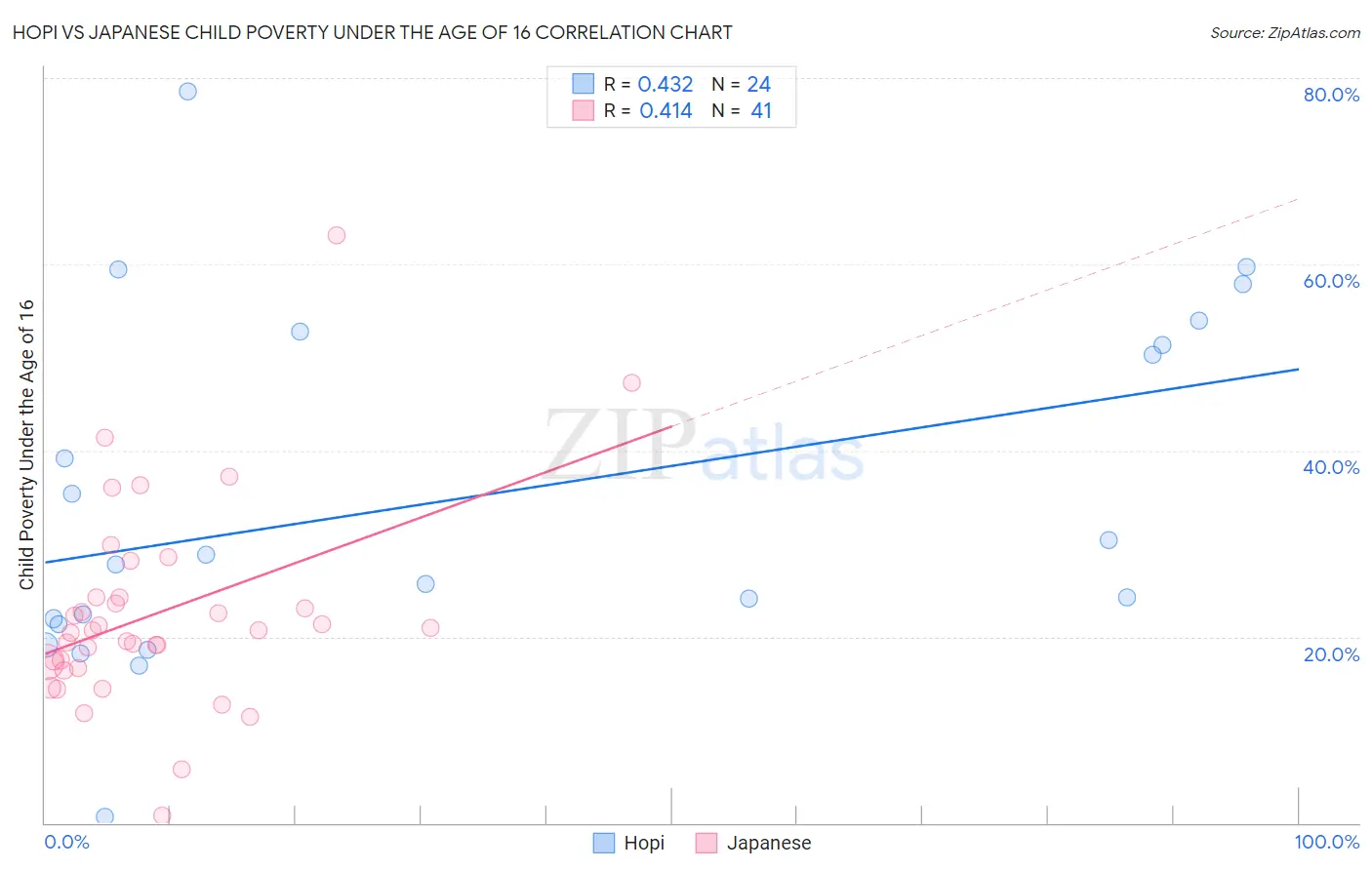Hopi vs Japanese Child Poverty Under the Age of 16
COMPARE
Hopi
Japanese
Child Poverty Under the Age of 16
Child Poverty Under the Age of 16 Comparison
Hopi
Japanese
27.1%
CHILD POVERTY UNDER THE AGE OF 16
0.0/ 100
METRIC RATING
340th/ 347
METRIC RANK
17.7%
CHILD POVERTY UNDER THE AGE OF 16
4.7/ 100
METRIC RATING
219th/ 347
METRIC RANK
Hopi vs Japanese Child Poverty Under the Age of 16 Correlation Chart
The statistical analysis conducted on geographies consisting of 74,667,106 people shows a moderate positive correlation between the proportion of Hopi and poverty level among children under the age of 16 in the United States with a correlation coefficient (R) of 0.432 and weighted average of 27.1%. Similarly, the statistical analysis conducted on geographies consisting of 248,294,497 people shows a moderate positive correlation between the proportion of Japanese and poverty level among children under the age of 16 in the United States with a correlation coefficient (R) of 0.414 and weighted average of 17.7%, a difference of 53.4%.

Child Poverty Under the Age of 16 Correlation Summary
| Measurement | Hopi | Japanese |
| Minimum | 0.70% | 0.73% |
| Maximum | 78.6% | 63.1% |
| Range | 77.9% | 62.3% |
| Mean | 34.9% | 22.5% |
| Median | 28.3% | 20.6% |
| Interquartile 25% (IQ1) | 21.6% | 16.9% |
| Interquartile 75% (IQ3) | 52.0% | 24.2% |
| Interquartile Range (IQR) | 30.4% | 7.3% |
| Standard Deviation (Sample) | 18.7% | 11.0% |
| Standard Deviation (Population) | 18.4% | 10.9% |
Similar Demographics by Child Poverty Under the Age of 16
Demographics Similar to Hopi by Child Poverty Under the Age of 16
In terms of child poverty under the age of 16, the demographic groups most similar to Hopi are Crow (26.0%, a difference of 4.4%), Yuman (28.9%, a difference of 6.8%), Cheyenne (25.4%, a difference of 6.8%), Pima (29.0%, a difference of 7.1%), and Immigrants from Yemen (29.1%, a difference of 7.3%).
| Demographics | Rating | Rank | Child Poverty Under the Age of 16 |
| Immigrants | Dominican Republic | 0.0 /100 | #333 | Tragic 24.0% |
| Blacks/African Americans | 0.0 /100 | #334 | Tragic 24.4% |
| Houma | 0.0 /100 | #335 | Tragic 24.9% |
| Yup'ik | 0.0 /100 | #336 | Tragic 25.1% |
| Sioux | 0.0 /100 | #337 | Tragic 25.2% |
| Cheyenne | 0.0 /100 | #338 | Tragic 25.4% |
| Crow | 0.0 /100 | #339 | Tragic 26.0% |
| Hopi | 0.0 /100 | #340 | Tragic 27.1% |
| Yuman | 0.0 /100 | #341 | Tragic 28.9% |
| Pima | 0.0 /100 | #342 | Tragic 29.0% |
| Immigrants | Yemen | 0.0 /100 | #343 | Tragic 29.1% |
| Navajo | 0.0 /100 | #344 | Tragic 30.2% |
| Lumbee | 0.0 /100 | #345 | Tragic 31.0% |
| Tohono O'odham | 0.0 /100 | #346 | Tragic 31.7% |
| Puerto Ricans | 0.0 /100 | #347 | Tragic 32.5% |
Demographics Similar to Japanese by Child Poverty Under the Age of 16
In terms of child poverty under the age of 16, the demographic groups most similar to Japanese are Moroccan (17.6%, a difference of 0.36%), Immigrants from Eastern Africa (17.6%, a difference of 0.37%), Immigrants from Panama (17.7%, a difference of 0.40%), Sierra Leonean (17.6%, a difference of 0.56%), and Malaysian (17.5%, a difference of 0.67%).
| Demographics | Rating | Rank | Child Poverty Under the Age of 16 |
| Immigrants | Immigrants | 6.5 /100 | #212 | Tragic 17.5% |
| Immigrants | Azores | 6.2 /100 | #213 | Tragic 17.5% |
| Iraqis | 5.9 /100 | #214 | Tragic 17.5% |
| Malaysians | 5.9 /100 | #215 | Tragic 17.5% |
| Sierra Leoneans | 5.7 /100 | #216 | Tragic 17.6% |
| Immigrants | Eastern Africa | 5.3 /100 | #217 | Tragic 17.6% |
| Moroccans | 5.3 /100 | #218 | Tragic 17.6% |
| Japanese | 4.7 /100 | #219 | Tragic 17.7% |
| Immigrants | Panama | 4.1 /100 | #220 | Tragic 17.7% |
| Cubans | 3.7 /100 | #221 | Tragic 17.8% |
| Immigrants | Armenia | 3.6 /100 | #222 | Tragic 17.8% |
| Immigrants | Cambodia | 3.3 /100 | #223 | Tragic 17.8% |
| Osage | 3.1 /100 | #224 | Tragic 17.9% |
| Immigrants | Nonimmigrants | 2.7 /100 | #225 | Tragic 17.9% |
| Bermudans | 2.6 /100 | #226 | Tragic 18.0% |